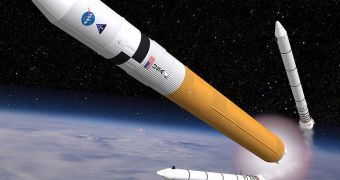On Monday, members of the House Science and Technology Committee released the draft text of a new bill, that sets new directions for NASA and the American space program as a whole. The new approach aims to pretty much keep Project Constellation intact, while also agreeing to fund the private sector. Admittedly, this will be done to a more reduced extent than proposed under US President Barack Obama's original proposition, Space reports.
When Congress approved Constellation, some five years ago, it also set in place measures to ensure that NASA could not end the Project on its own. This proved useful throughout this year, as talks of sacking the endeavor raged on. But project managers related to Constellation were advised to continue working throughout 2010, as funding was secured for their convenience by the end of this year. This means that, if the new bill passes, the engineers working on putting America back on the map, space exploration-wise, did not miss out on any of their work.
The focus of the draft is to produce a field-testable vehicle for delivering astronauts to and from the Moon by no later than 2015. This is also the original deadline for the ARES I rocket and the Orion Crew Exploration Vehicle, the components in Constellation that were designed specifically to return people to the Moon. The text calls for a new heavy-lift rocket to be created based on the delivery system the space shuttles currently use, rather than NASA focusing on developing its massive ARES V. On the other hand, agency funding for the private sector is reduced to only $250 million, as opposed to Obama's planned $6 billion over five years.
“This is a bipartisan bill that embraces many of the president's goals for our space program while also ensuring that we have an executable and fiscally responsible plan. For too long, the tasks NASA has been asked to undertake haven't been matched to available resources. We are facing tough economic times that demand tough choices. We can't do it all. This bill makes those choices and provides the nation with a credible, sustainable, and worthy space and aeronautics program,” says the chairman of the House Science and Technology Committee, Rep. Bart Gordon (D-Tenn.). He issued a press release announcing the draft late on Monday.
But not everyone is happy with the new decision. Understandably, private companies are most disappointed with the way things turned out. “Based on the proposed levels of funding for Russian Soyuz flights versus commercial crew services, it would appear that the House Science Committee has more faith in Russian technology developed in the 1960s than in America's own aerospace industry.At a time when private companies are willing to invest their own money to help create jobs, the House Science Committee bill is a clear job destroyer,” said the president of the Commercial Spaceflight Federation, Bretton Alexander.
He was referring to the fact that, until 2015, the US will have to rely on Russian-built spacecraft to access the International Space Station (ISS). But critics to his point of view draw attention to the fact that the money the US would save by not investing in the private sector (about $5.7 billion), would be more than enough for creating new facilities, and for paying for Constellation at least a few years in advance.

 14 DAY TRIAL //
14 DAY TRIAL //